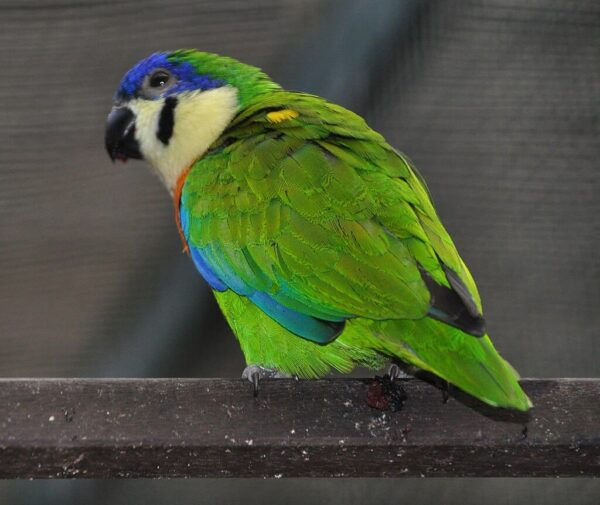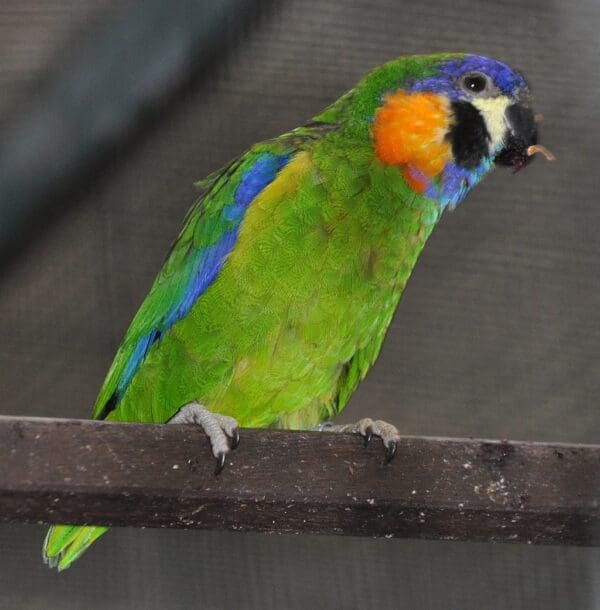Orange-breasted Fig Parrot
Also known as:
William's Fig Parrot, King of Holland's Fig Parrot
Also known as:
William's Fig Parrot, King of Holland's Fig Parrot
DID YOU KNOW?
The small fig parrots of the genus (group) Cyclopsitta are also called lorilets.

Cyclopsitta

gulielmitertii
Size:
13 cm (5.1 in)
Weight:
28-35 g (1-1.2 oz)
Subspecies including nominate:
one
Colour Adult:
Male-deep blue forehead and forecrown to area behind eyes; pale yellow lores, throat, and sides of head; black mark on back of cheek; breast and upper abdomen orange; inner wing coverts edged with yellow; wide pale yellow bands on underwings. Beak grey/black. Eye dark brown. Female-as in male but pale yellow at front of cheeks and black at back; forecheeks bordered below by green/blue stripe; ear coverts to sides of neck orange; green underparts.
Colour Juvenile:
As in female but orange from ear coverts and sides of neck to area below front of cheeks; breast of males washed with orange/brown.
Call:
Calls in flight shrill and penetrating notes repeated at short pauses. Some sounds sharp. Also subdued chattering while feeding.
More Information:
Content Sources:
CITES
BirdLife International
Cornell Lab of Ornithology/Birds of the World
Parrots: A Guide to Parrots of the World, Juniper and Parr, 1998
Parrots of the World, Forshaw, 2006. 2010 edition
Parrots in Aviculture, Low, 1992.
Lexicon of Parrots, Thomas Arndt.
Guide to Incubation and Handraising Parrots, Digney, 1998.
Article “The Orange-breasted Fig Parrot”, by Peter Odekerken, Australian Birdkeeper, Oct-Nov 2005
Captive Status:
Rare
Longevity:
—
Housing:
Walk-in enclosure, minimum length 2.1 m (7 ft). Planted if possible.
Diet:
Dried soaked figs (soak in water a few hours), two or more per bird per day; once daily, a drop of Konakion (Roche) or other vitamin K additive; fruit such as: apple, pear, orange, banana, pomegranate, forming at least 50 percent of diet; soaked sultanas; berries such as: elder, mountain ash, pyracantha; spray millet; small seed mixture such as: canary, oats safflower, limited sunflower; cooked beans and pulses; rearing food: hard-boiled egg, wholegrain bread and carrot, all ground to crumbly consistency. Complete pellet, if taken. Breeding diet: some pairs consume mealworms mainly for first 3 weeks of chicks’ lives, also well-cleaned maggots or proprietary insectivorous food. Withhold seed for first 3 weeks of chicks’ lives.
Enrichment:
Provide planted aviary. Also provide lots of bird-safe branches and browse for the parrots to chew on. Bathing areas are enjoyed.
Nest Box Size:
Nest log 4″ (10.1 cm) wide x 10″ (25.4 cm) high.
Clutch Size:
2
Fledging Age:
5.5-7.5 weeks
Hatch Weight:
—
Peak Weight:
—
Weaning Weight:
—
World Population:
About 100,000 breeding pairs (1990s).
IUCN Red List Status:
Least Concern
CITES Listing:
Appendix II
Threat Summary:
Not globally threatened.
Range:
Salawati, W Papuan Islands, and nearby western regions of Vogelkop Peninsula, West Papua.
Habitat:
Found in rainforest, swamp forest, Melaleuca woodland, dense savanna and partly cleared areas up to 1100 m (3608 ft), mostly below 500 m (1640 ft).
Wild Diet:
Diet includes seeds of Ficus figs, Glochidion and Acacia auriculaeformis, as well as whole small fruits, nectar from flowers and occasionally insects.
Ecology and Behaviour:
Found in small active groups of 6-10 individuals, either flying above the forest calling or grouping together to forage for figs or other fruits in the canopy. Birds feed quietly and are difficult to detect as they clamber around. May signal their presence by hanging upside down while feeding, dropping fruit as they do so.
Clutch and Egg Size:
2 eggs
Breeding Season:
December-June; nest is in arboreal termitarium or sometimes an epiphyte.
Related Links:
—


![© Quartl (Own work) [CC BY-SA 3.0] via Wikimedia Commons A companion Orange-breasted Fig Parrot perches](https://gt2024.parrots.org/wp-content/uploads/1990/08/Orange-breasted-Fig-Parrot-Quartl-e1732298864630-100x100.jpg)
![© Quartl (Own work) [CC BY-SA 3.0] via Wikimedia Commons A companion Orange-breasted Fig Parrot perches](https://gt2024.parrots.org/wp-content/uploads/1990/08/Orange-breasted-Fig-Parrot-Quartl-CC-BY-SA-3.0-via-Wikimedia-Commons-100x100.jpg)